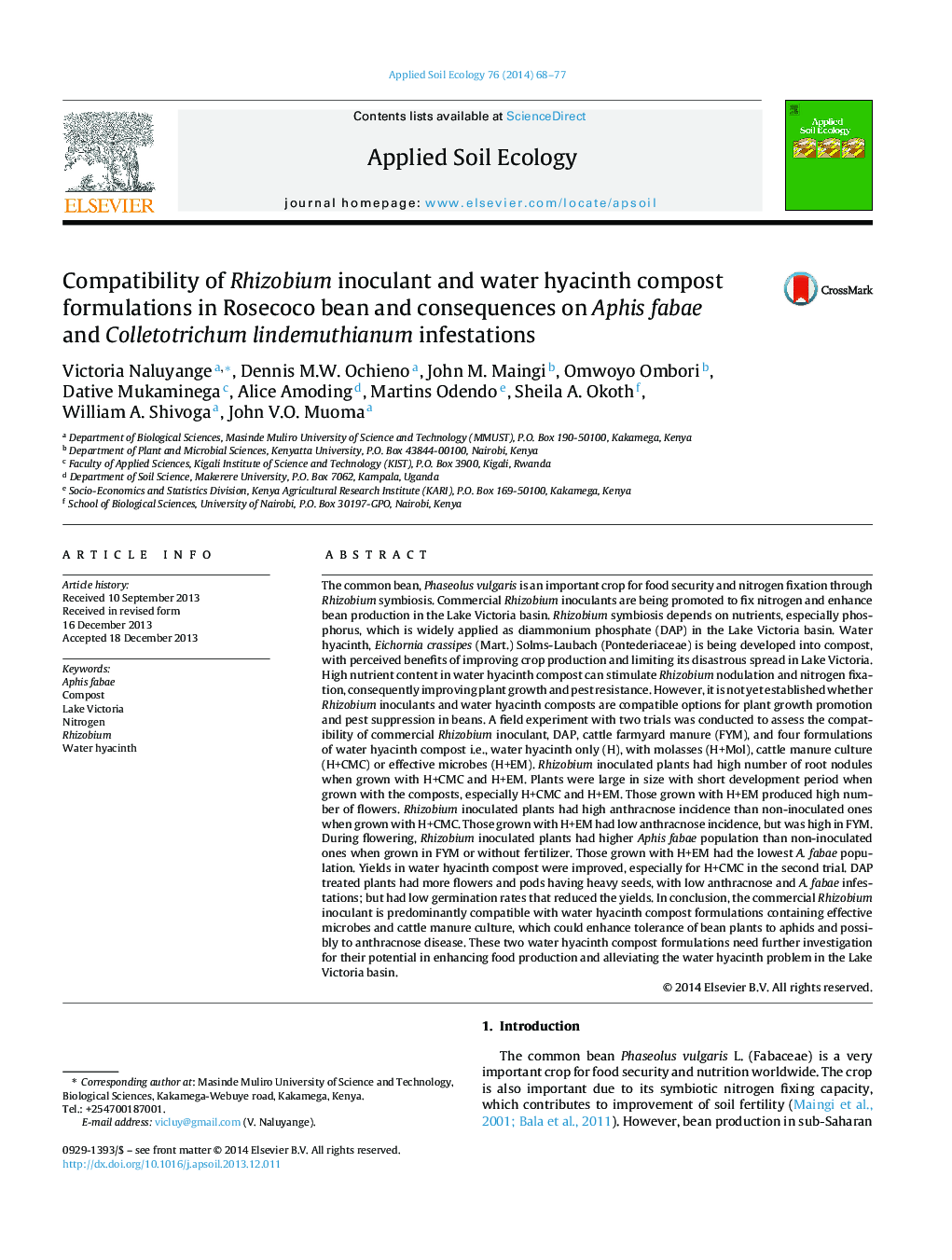| کد مقاله | کد نشریه | سال انتشار | مقاله انگلیسی | نسخه تمام متن |
|---|---|---|---|---|
| 4382262 | 1617807 | 2014 | 10 صفحه PDF | دانلود رایگان |
عنوان انگلیسی مقاله ISI
Compatibility of Rhizobium inoculant and water hyacinth compost formulations in Rosecoco bean and consequences on Aphis fabae and Colletotrichum lindemuthianum infestations
دانلود مقاله + سفارش ترجمه
دانلود مقاله ISI انگلیسی
رایگان برای ایرانیان
کلمات کلیدی
موضوعات مرتبط
علوم زیستی و بیوفناوری
علوم کشاورزی و بیولوژیک
بوم شناسی، تکامل، رفتار و سامانه شناسی
پیش نمایش صفحه اول مقاله

چکیده انگلیسی
The common bean, Phaseolus vulgaris is an important crop for food security and nitrogen fixation through Rhizobium symbiosis. Commercial Rhizobium inoculants are being promoted to fix nitrogen and enhance bean production in the Lake Victoria basin. Rhizobium symbiosis depends on nutrients, especially phosphorus, which is widely applied as diammonium phosphate (DAP) in the Lake Victoria basin. Water hyacinth, Eichornia crassipes (Mart.) Solms-Laubach (Pontederiaceae) is being developed into compost, with perceived benefits of improving crop production and limiting its disastrous spread in Lake Victoria. High nutrient content in water hyacinth compost can stimulate Rhizobium nodulation and nitrogen fixation, consequently improving plant growth and pest resistance. However, it is not yet established whether Rhizobium inoculants and water hyacinth composts are compatible options for plant growth promotion and pest suppression in beans. A field experiment with two trials was conducted to assess the compatibility of commercial Rhizobium inoculant, DAP, cattle farmyard manure (FYM), and four formulations of water hyacinth compost i.e., water hyacinth only (H), with molasses (H+Mol), cattle manure culture (H+CMC) or effective microbes (H+EM). Rhizobium inoculated plants had high number of root nodules when grown with H+CMC and H+EM. Plants were large in size with short development period when grown with the composts, especially H+CMC and H+EM. Those grown with H+EM produced high number of flowers. Rhizobium inoculated plants had high anthracnose incidence than non-inoculated ones when grown with H+CMC. Those grown with H+EM had low anthracnose incidence, but was high in FYM. During flowering, Rhizobium inoculated plants had higher Aphis fabae population than non-inoculated ones when grown in FYM or without fertilizer. Those grown with H+EM had the lowest A. fabae population. Yields in water hyacinth compost were improved, especially for H+CMC in the second trial. DAP treated plants had more flowers and pods having heavy seeds, with low anthracnose and A. fabae infestations; but had low germination rates that reduced the yields. In conclusion, the commercial Rhizobium inoculant is predominantly compatible with water hyacinth compost formulations containing effective microbes and cattle manure culture, which could enhance tolerance of bean plants to aphids and possibly to anthracnose disease. These two water hyacinth compost formulations need further investigation for their potential in enhancing food production and alleviating the water hyacinth problem in the Lake Victoria basin.
ناشر
Database: Elsevier - ScienceDirect (ساینس دایرکت)
Journal: Applied Soil Ecology - Volume 76, April 2014, Pages 68-77
Journal: Applied Soil Ecology - Volume 76, April 2014, Pages 68-77
نویسندگان
Victoria Naluyange, Dennis M.W. Ochieno, John M. Maingi, Omwoyo Ombori, Dative Mukaminega, Alice Amoding, Martins Odendo, Sheila A. Okoth, William A. Shivoga, John V.O. Muoma,